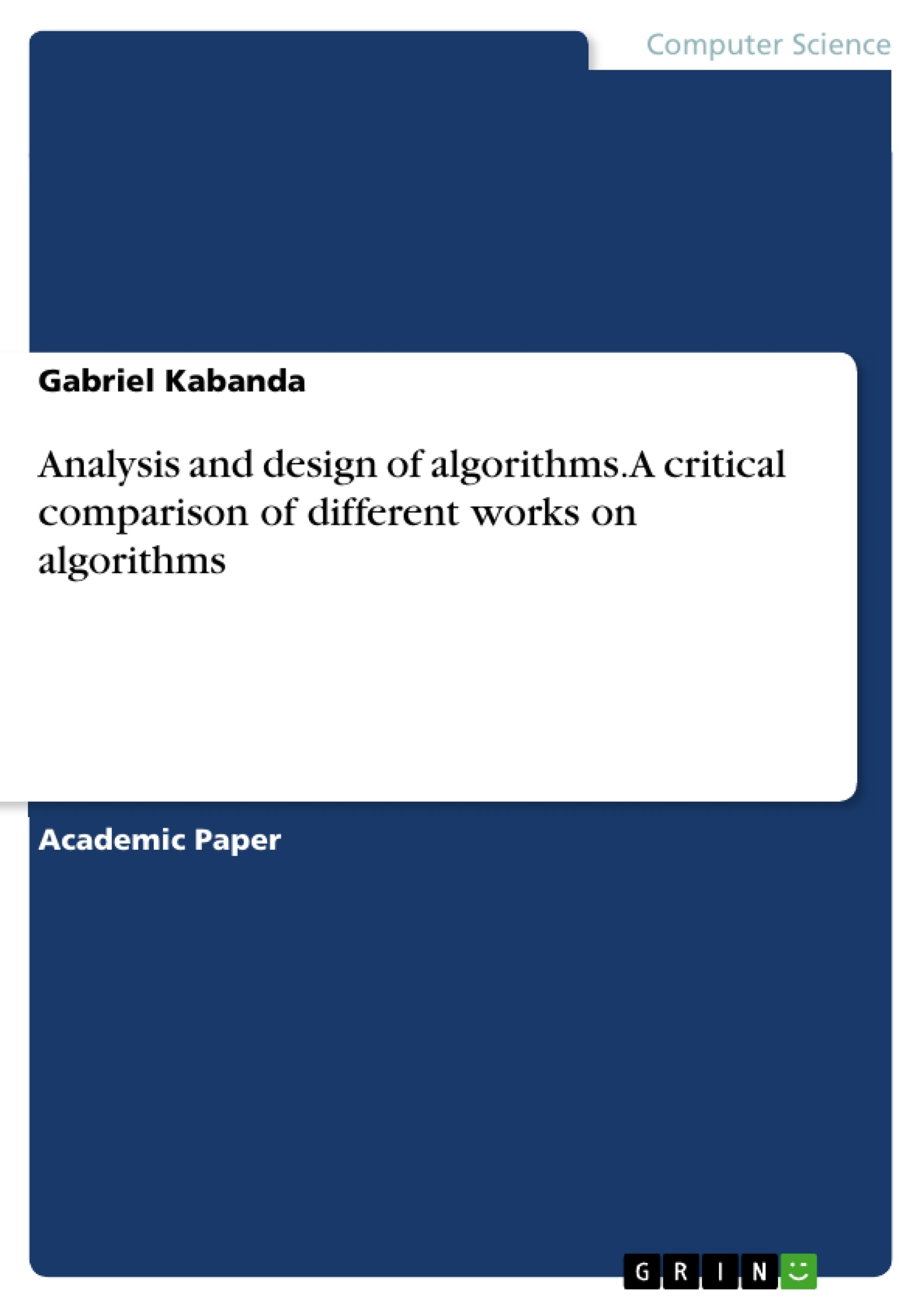The paper presents an analytical exposition, a critical context, and an integrative conclusion on the six major text books on Algorithms design and analysis.
Algorithms form the heart of Computer Science in general. An algorithm is simply a set of steps to accomplish or complete a task that is described precisely enough that a computer can run it. It is a sequence of unambiguous instructions for solving a problem, and is used for obtaining a required output for any legitimate input in a finite amount of time. Algorithms can be considered as procedural solutions to problems where the focus is on correctness and efficiency.
The important problem types are sorting, searching, string processing, graph problems, combinatorial problems, geometric problems, and numerical problems.
Table of Contents
- Analytical Exposition
- Brute Force
- Decrease-and-Conquer
Objectives and Key Themes
This paper provides an analysis of six major textbooks on algorithm design and analysis. It examines various algorithm design techniques, analyzes their efficiency, and explores different approaches to problem-solving.
- Algorithm Design Techniques
- Algorithm Efficiency Analysis
- Brute Force Approach
- Decrease-and-Conquer Strategy
- Algorithm Classification
Chapter Summaries
Analytical Exposition: This chapter offers a comprehensive overview of algorithm design and analysis, defining algorithms as precise sequences of instructions for solving problems within a finite time. It highlights the importance of correctness and efficiency, and introduces key problem types such as sorting, searching, and graph problems. The chapter delves into algorithm design techniques, emphasizing the importance of choosing the right approach based on the problem's nature. It discusses different ways to classify algorithms, including grouping them by problem type or underlying design techniques. The Stable Matching Problem is introduced as an example illustrating many themes in algorithm design. The chapter also touches upon algorithm analysis, including worst-case, best-case, average-case, and amortized analysis, along with the significance of data structures in efficient problem-solving. The chapter concludes by defining time and space complexity and their importance in evaluating algorithm efficiency.
Brute Force: This section details the brute-force approach, a straightforward method that directly addresses problem statements and definitions. While lauded for its simplicity and wide applicability, its often subpar efficiency is noted. The chapter uses examples like selection sort, sequential search, and straightforward string-matching to illustrate the brute-force technique. It then moves to the exhaustive search method for combinatorial problems, discussing its practicality limitations except in specific, limited problem instances. The chapter contrasts the exhaustive search with more efficient graph-traversal algorithms like Depth-first search (DFS) and Breadth-first search (BFS), comparing their time efficiencies based on different graph representations.
Decrease-and-Conquer: This chapter explores the decrease-and-conquer strategy, a general algorithm design technique that leverages the relationship between a problem's solution and a smaller instance of the same problem. The chapter explains how this relationship can be exploited recursively (top-down) or iteratively (bottom-up). Three main variations of decrease-and-conquer are presented: decrease-by-a-constant (e.g., insertion sort), decrease-by-a-constant-factor (e.g., binary search), and variable-size-decrease (e.g., Euclid's algorithm). The chapter highlights the effectiveness of this technique in solving various computational problems by reducing problem size progressively.
Keywords
Algorithm design, algorithm analysis, algorithm efficiency, brute force, decrease-and-conquer, time complexity, space complexity, data structures, sorting, searching, graph algorithms, combinatorial problems.
Algorithm Design and Analysis Text: Frequently Asked Questions
What is the purpose of this text?
This text provides a comprehensive overview of algorithm design and analysis techniques, focusing on six major textbooks in the field. It analyzes various techniques, their efficiency, and different approaches to problem-solving.
What topics are covered in the text?
The text covers algorithm design techniques, algorithm efficiency analysis, brute force approaches, decrease-and-conquer strategies, algorithm classification, and the use of data structures in efficient problem-solving. Specific examples include sorting algorithms (like selection sort and insertion sort), searching algorithms (like sequential search and binary search), and graph traversal algorithms (like Depth-first search and Breadth-first search). The Stable Matching Problem is also discussed as a case study.
What are the main algorithm design techniques discussed?
The text primarily focuses on the brute force and decrease-and-conquer approaches. Brute force is described as a straightforward, often inefficient, method that directly addresses the problem. Decrease-and-conquer involves solving a problem by recursively or iteratively reducing it to a smaller instance of the same problem. Variations like decrease-by-a-constant, decrease-by-a-constant-factor, and variable-size-decrease are explored.
How is algorithm efficiency analyzed in the text?
The text discusses analyzing algorithm efficiency through worst-case, best-case, average-case, and amortized analysis. Time and space complexity are defined and their importance in evaluating algorithm efficiency is highlighted.
What are the key concepts related to algorithm analysis?
Key concepts include time complexity, space complexity, and the analysis of algorithm efficiency based on different scenarios (worst-case, best-case, average-case, amortized). The importance of data structures in optimizing algorithms is also emphasized.
What types of problems are examined?
The text examines various problem types, including sorting, searching, and graph problems, as well as combinatorial problems where exhaustive search is discussed and compared to more efficient graph-traversal techniques.
What are the chapter summaries about?
The chapter summaries provide detailed overviews of the core concepts covered in each section, including definitions, examples, and comparisons of different algorithmic approaches. They offer a concise yet comprehensive outline of the text's content.
What are the keywords associated with this text?
Keywords include algorithm design, algorithm analysis, algorithm efficiency, brute force, decrease-and-conquer, time complexity, space complexity, data structures, sorting, searching, graph algorithms, and combinatorial problems.
What is the overall structure of the text?
The text is structured with a table of contents, objectives and key themes, chapter summaries, and keywords. This allows for a clear and organized understanding of the material covered.
- Arbeit zitieren
- Professor Gabriel Kabanda (Autor:in), 2019, Analysis and design of algorithms. A critical comparison of different works on algorithms, München, GRIN Verlag, https://www.hausarbeiten.de/document/491406


